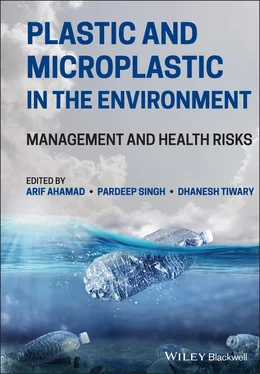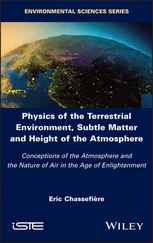Plastic and Microplastic in the Environment
Здесь есть возможность читать онлайн «Plastic and Microplastic in the Environment» — ознакомительный отрывок электронной книги совершенно бесплатно, а после прочтения отрывка купить полную версию. В некоторых случаях можно слушать аудио, скачать через торрент в формате fb2 и присутствует краткое содержание. Жанр: unrecognised, на английском языке. Описание произведения, (предисловие) а так же отзывы посетителей доступны на портале библиотеки ЛибКат.
- Название:Plastic and Microplastic in the Environment
- Автор:
- Жанр:
- Год:неизвестен
- ISBN:нет данных
- Рейтинг книги:5 / 5. Голосов: 1
-
Избранное:Добавить в избранное
- Отзывы:
-
Ваша оценка:
- 100
- 1
- 2
- 3
- 4
- 5
Plastic and Microplastic in the Environment: краткое содержание, описание и аннотация
Предлагаем к чтению аннотацию, описание, краткое содержание или предисловие (зависит от того, что написал сам автор книги «Plastic and Microplastic in the Environment»). Если вы не нашли необходимую информацию о книге — напишите в комментариях, мы постараемся отыскать её.
Thought-provoking discussions of the challenges posed by—and potential solutions to—plastic and microplastic pollution Plastic and Microplastic in the Environment: Management and Health Risks,
Plastic and Microplastic in the Environment
Plastic and Microplastic in the Environment: Management and Health Risks
Plastic and Microplastic in the Environment — читать онлайн ознакомительный отрывок
Ниже представлен текст книги, разбитый по страницам. Система сохранения места последней прочитанной страницы, позволяет с удобством читать онлайн бесплатно книгу «Plastic and Microplastic in the Environment», без необходимости каждый раз заново искать на чём Вы остановились. Поставьте закладку, и сможете в любой момент перейти на страницу, на которой закончили чтение.
Интервал:
Закладка:
83 Suman, T.Y., Li, W.G., Alif, S. et al. (2020). Characterization of petroleum‐based plastics and their absorbed trace metals from the sediments of the Marina Beach in Chennai, India. Environmental Sciences Europe 32 (1): 1–10.
84 Sundt, P., Schulze, P.‐E., and Syversen, F. (2014). Sources of microplastic pollution to the marine environment. Mepex for the Norwegian Environment Agency (Miljødirektoratet): 86.
85 Tan, X., Yu, X., Cai, L. et al. (2019). Microplastics and associated PAHs in surface water from the Feilaixia reservoir in the Beijiang River, China. Chemosphere 221: 834–840.
86 Tanaka, K. and Takada, H. (2016). Microplastic fragments and microbeads in digestive tracts of planktivorous fish from urban coastal waters. Scientific Reports 6 (1): 1–8.
87 Tanaka, K., Takada, H., Yamashita, R. et al. (2013). Accumulation of plastic‐derived chemicals in tissues of seabirds ingesting marine plastics. Marine Pollution Bulletin 69 (1–2): 219–222.
88 Tanaka, K., Takada, H., Yamashita, R. et al. (2015). Facilitated leaching of additive‐derived PBDEs from plastic by seabirds' stomach oil and accumulation in tissues. Environmental Science and Technology 49: 11799–11807. https://doi.org/10.1021/acs.est.5b01376.
89 Thompson, R. (2017). Environment: a journey on plastic seas. Nature 547 (7663): 278.
90 Thompson, R.C., Swan, S.H., Moore, C.J. and Vom Saal, F.S. (2009). Our plastic age. royalsocietypublishing.org(accessed 26 October 2021).
91 Toxics Link (2014). Plastics and the Environment, Assessing the Impact of the Complete Ban on Plastic Carry Bag. New Delhi, India: Central Pollution Control Board (CPCB) http://toxicslink.org/docs/Full‐Report‐Plastic‐and‐the‐Environment.pdf.
92 Tramoy, R., Gasperi, J., Dris, R. et al. (2019). Assessment of the plastic inputs from the seine basin to the sea using statistical and field approaches. Frontiers in Marine Science 6: 151.
93 UNHSP (United Nations Human Settlements Programme) (2016). World Cities Report. Nairobi, Kenya: United Nations Human Settlements Programme.
94 Van Cauwenberghe, L. and Janssen, C.R. (2014). Microplastics in bivalves cultured for human consumption. Environmental Pollution 193: 65–70.
95 Veerasingam, S., Mugilarasan, M., Venkatachalapathy, R., and Vethamony, P. (2016). Influence of 2015 flood on the distribution and occurrence of microplastic pellets along the Chennai coast, India. Marine Pollution Bulletin 109 (1): 196–204.
96 Verster, C., Minnaar, K., and Bouwman, H. (2017). Marine and freshwater microplastic research in South Africa. Integrated Environmental Assessment and Management 13 (3): 533–535.
97 Wagner, M., Scherer, C., Alvarez‐Muñoz, D. et al. (2014). Microplastics in freshwater ecosystems: what we know and what we need to know. Environmental Sciences Europe 26 (1): 1–9.
98 Werner, S., Budziak, A., van Franeker, J.A. et al. (2016). Harm caused by Marine Litter. MSFD GES TG Marine Litter – Thematic Report EUR 28317. Luxembourg.
99 Wilson, H.L., Johnson, M.F., Wood, P.J. et al. (2020). Anthropogenic litter is a novel habitat for aquatic macroinvertebrates in urban rivers. Freshwater Biology 66: 524–534.
100 Windsor, F.M., Durance, I., Horton, A.A. et al. (2019). A catchment‐scale perspective of plastic pollution. Global Change Biology 25 (4): 1207–1221.
101 Wright, S.L. and Kelly, F.J. (2017). Threat to human health from environmental plastics. BMJ 358: j4334. https://doi.org/10.1136/bmj.j4334.
102 Yonkos, L.T., Friedel, E.A., Perez‐Reyes, A.C. et al. (2014). Microplastics in four estuarine rivers in the Chesapeake Bay, USA. Environmental Science & Technology 48 (24): 14195–14202.
103 Zhao, S., Zhu, L., Wang, T., and Li, D. (2014). Suspended microplastics in the surface water of the Yangtze estuary system, China: first observations on occurrence, distribution. Marine Pollution Bulletin 86 (1–2): 562–568.
104 Ziajahromi, S., Neale, P.A., and Leusch, F.D. (2016). Wastewater treatment plant effluent as a source of microplastics: review of the fate, chemical interactions and potential risks to aquatic organisms. Water Science and Technology 74 (10): 2253–2269.
105 Ziajahromi, S., Kumar, A., Neale, P.A., and Leusch, F.D. (2017). Impact of microplastic beads and fibers on waterflea (Ceriodaphniadubia) survival, growth, and reproduction: implications of single and mixture exposures. Environmental Science & Technology 51 (22): 13397–13406.
3 Microplastic Contamination in the Marine Food Web: Its Impact on Human Health
Richa Singh
Institute of Environment and Sustainable Development, Banaras Hindu University, Varanasi, Uttar Pradesh, India
3.1 Introduction
Plastic or synthetic polymers are artificially made from petroleum products, and due to their versatile nature of being lightweight, strong, durable, transparent, and waterproof they are now part of everything we human beings use. Thus, they are widely distributed to the entire segment of human life, from waking up in the morning until going to bed at night; modern humans are surrounded by plastic. Plastics have proliferated into food packaging industries; stationary, electric, and electronic goods; vehicles, private and public transport; medical appliances; fishing nets and more. In today's era, one cannot imagine a day without plastic. Toothpastes, shaving creams, and soaps all have synthetic polymers in the form of microbeads (Sun et al. 2020). Plastics are highly resistant to microbial degradation as they are of artificial (human‐made) petroleum‐based products; therefore, their remediation by natural processes is difficult enough and takes a long time that can vary in the range of hundreds of years (Wierckx et al. 2018). Due to chemical (acid rain) and physical (temperature, pressure, moisture) processes, they degrade and break down into smaller fragments and, in smaller forms which do not degrade completely and pose negative impacts on the environment, these smaller forms have high potential to enter into the water or air matrices in invisible forms. MPs have a size ranging from 100 nm to 5 mm (Zhang et al. 2020). The microbeads and nanoparticles that are intentionally added into facewash, shaving creams, soaps, etc. are termed “primary” MPs; however, those which are added to the environment after the fragmentation of larger size plastic particles by impact of natural phenomenon, as well as anthropogenic activities in the environment, are considered “secondary” MPs (Lei et al. 2017). Due to poor waste management practices and lack of knowledge about proper disposal of such wastes among the consumers of such plastic‐based products, plastic debris is dumped directly into the ocean every year in huge quantities. Varying sizes of plastic particles, including larger and smaller beads of MPs, ultimately reach the water column of the ocean, and their presence is significantly reported in sediments (Harris 2020). They are found on the deep floor of the sea, in underground water tables, and in soils. Global plastic production has significantly boomed from 300 to 360 million metric tons in the last five years ( Deccan Herald , 2020). As they are highly resistant to microbial degradation, they persist for a longer time in the ecosystem. MPs are a matter of great concern because of their high potential to make any organism unfit, as they have huge impacts on their metabolism.
According to Boucher & Friot (2017), approximately 1.53 million tons/year of primary MPs enter the ocean via different pathways. These pathways include flushed water from our washroom's containing the MPs in microbead form from face scrubs, toothpaste, detergents, facewash, shampoo, cosmetic cream, etc., which goes into rivers through the drainage systems, and later become part of the ocean, as sewage treatment plants are not made for such efficiency in developing countries like India. MPs are extensively distributed throughout our ocean ecosystem; from zooplankton, bivalves, crustacean, fish, and seabirds, and ultimately reach humans due to their extensive consumption and dependency on seafood (Santillo et al. 2017). In aquatic organisms, the uptake pathways of MPs are through their gills and gastrointestinal tracts (Franzellitti et al. 2019). The organisms are often confused as these colorful MP fragments look similar to plankton species on which they feed, and thus a significant portion of MPs reach and are accumulated in consumer organisms (Setälä et al. 2014). Sometimes these MPs are deposited on seaweed or algal blooms, and become part of the food to the organisms, where they enter the gastrointestinal tracts of organisms (Walkinshaw et al. 2020). Once these MPs are mistakenly consumed by smaller organisms in confusion of phytoplanktons, they make their way to successive trophic levels, as predators consume prey already having MPs in their guts. Polymers of rope, usually old fishing gear left deliberately or mistakenly in the ocean, can entangle marine creatures, suffocating them by restricting their mobility and unintentional killing them; this is referred to as “ghost fishing” (Gilman 2015). These polymers may also undergo reduction in size due to natural forces acting on them in the ocean, such as waves, water temperature, contact with other floating debris, or larger marine creatures nibbling the pieces into smaller fragments, which then contributes to MPs. Recent studies show the presence of MPs of an array of shapes and sizes in various organs of different organisms such as gills, liver, gut, muscles, etc. They cause disturbances in processes of metamorphosis, metabolism disorder, behavioral change, oxidative stress, genotoxicity, etc. (Rahman et al. 2021). This is becoming a food safety threat as these organisms are heavily consumed as food by humans as seafood, and contribute to a significant enough proportion of the daily diet of people in coastal areas; for example, India has a huge coastline of 7516.6 km.
Читать дальшеИнтервал:
Закладка:
Похожие книги на «Plastic and Microplastic in the Environment»
Представляем Вашему вниманию похожие книги на «Plastic and Microplastic in the Environment» списком для выбора. Мы отобрали схожую по названию и смыслу литературу в надежде предоставить читателям больше вариантов отыскать новые, интересные, ещё непрочитанные произведения.
Обсуждение, отзывы о книге «Plastic and Microplastic in the Environment» и просто собственные мнения читателей. Оставьте ваши комментарии, напишите, что Вы думаете о произведении, его смысле или главных героях. Укажите что конкретно понравилось, а что нет, и почему Вы так считаете.












